#morffew
Photo

White-tailed hawk.
© Andy Morffew / Wikimedia Commons
91 notes
·
View notes
Text


Swallow-tailed Kites (Elanoides forficatus), family Accipitridae, order Accipitriformes, FL, USA
Photographs by Andrew Morffew & Peter Brannon
939 notes
·
View notes
Text
BOTD: Common Pauraque

Photo: Andy Morffew
"After sunset, in the brushy woods of southern Texas, a hoarse wheezing whistle is heard from here and there in the undergrowth. As dusk settles in, a silhouetted bird flutters and glides silently through the clearings. This is the Pauraque, a common tropical nightjar. If disturbed by day at its resting place in dense thickets, it flutters away on a zigzag course, showing white flashes in the wings and tail."
- Audubon Field Guide
#birds#common pauraque#birds of north america#north american birds#pauraques#nightjars#birds of the us#birds of mexico#birds of central america#birding#bird watching#birdblr#birblr#bird of the day#Nyctidromus albicollis
163 notes
·
View notes
Text
Disney Villains as Birds
This idea just came in mind combining two fields I’m interested. Not just looking for the color but appearance, feeling and behavior also matters.
Very personal opinion you may disagree but friendly discussion welcomed :)
HERE WE GO!
Hans: Blue-breasted Fairywren (Malleus pulcherrimus)
Very cute and pretty-looking bird! Known for their unique courtship of delivering petals.
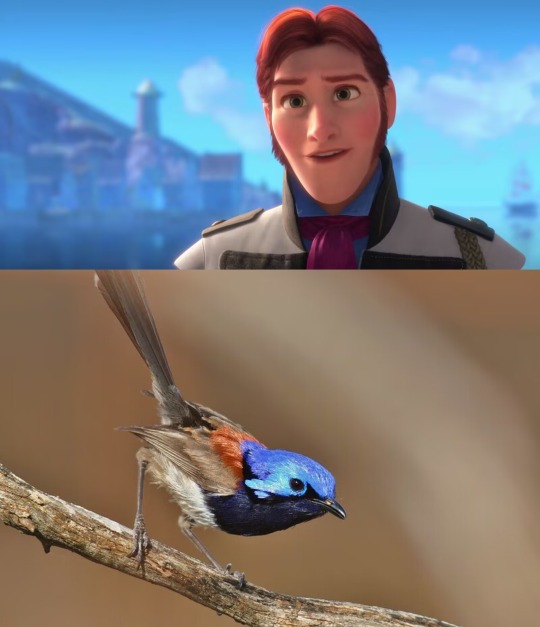
©Disney
©Laurie Boyle
Judge Claude Frollo: Demoiselle Crane (Grus virgo)
#That Hair

©Disney
©salis-
Hades: Steller’s Jay (Cyanocitta stelleri)
HE HAS TO BE A CORVIDAE. And just look at that hairstyle and that…eyebrows?

©Disney
©Daniel Plumer
Queen of Hearts: Papyrus Gonolek (Laniarius mufumbiri)
Fun fact: Like shrikes, they impale their prey on thorns.
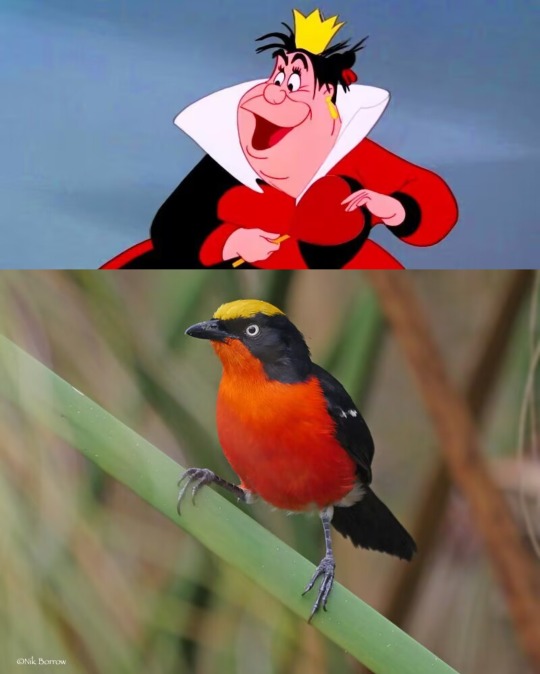
©Disney
©Nik Borrow
Queen Grimhilde: Black-shouldered Kite (Elanus axillaris)
Fairest bird of all

©Disney
©I Am birdsaspoetry.com
Jafar: Bearded Vulture (Gypaetus barbatus)
One of my fav. Now Iago has someone his same class.

©Disney
©pilot_micha
Yzma: Lesser Florican (Sypheotides indicus)
#THAT EYELASH

©Disney
There’s no copyright restriction on the other pic from website so I guess I’m good.
Cruella De Vil: Houbara Bustard (Chlamydotis undulata)
She would see the bird as her greatest accessory.

©Disney
©Frank Vassen
Dr. Facilier: Long-tailed Glossy Starling (Lamprotornis caudatus)
The metallic effect of their plumage just matches Facilier’s shadow power and colorful effects made by his friends on the other side.
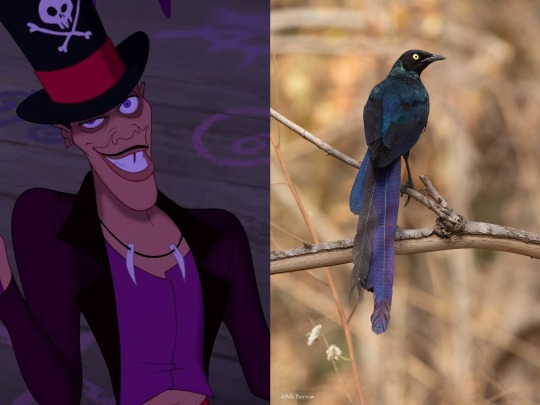
©Disney
©Nik Borrow
Mother Gothel: Long-tailed Paradise Whydah (Vidua paradisaea)
Known to be brood parasites like cuckoos.
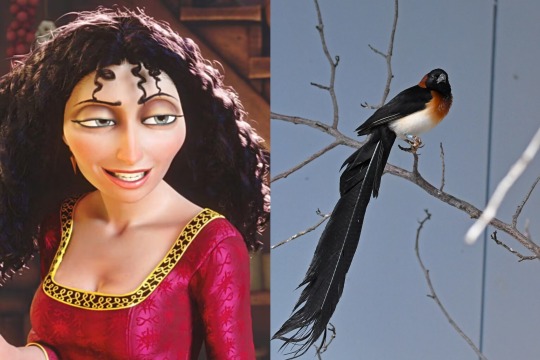
©Disney
©Brian Henderson
Gaston: Western Capercaillie (Tetrao urogallus)
No one makes that mating call like Gaston!
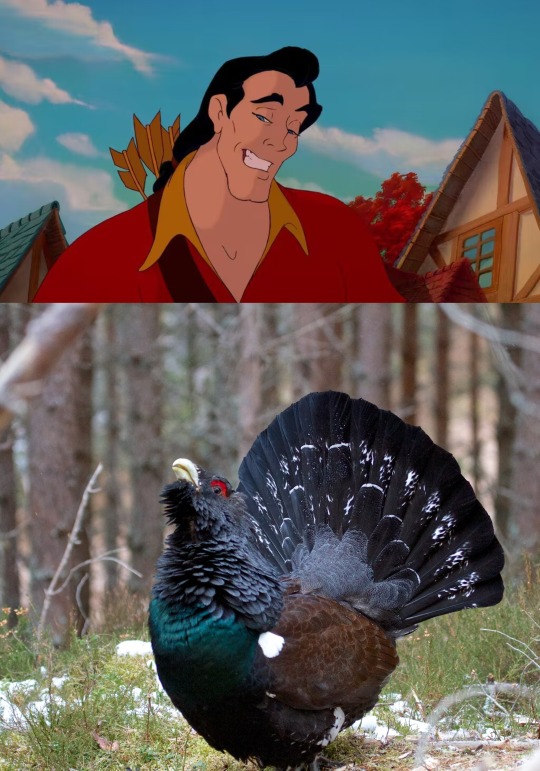
©Disney
©sighmanb
Ursula: Peruvian Pelican (Pelecanus thagus)
Those who couldn’t pay their price were devoured, FOR SURE
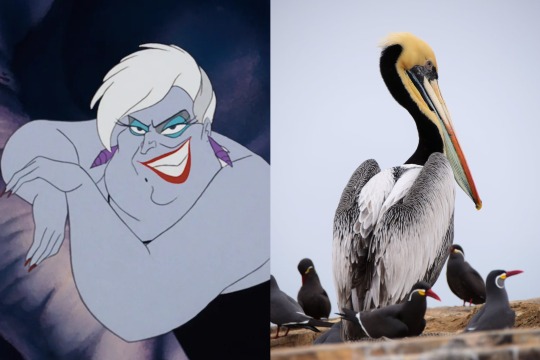
©Disney
©Rogerio Camboim S A
Maleficent: Common Raven (Corvus corax)
Need I say more?
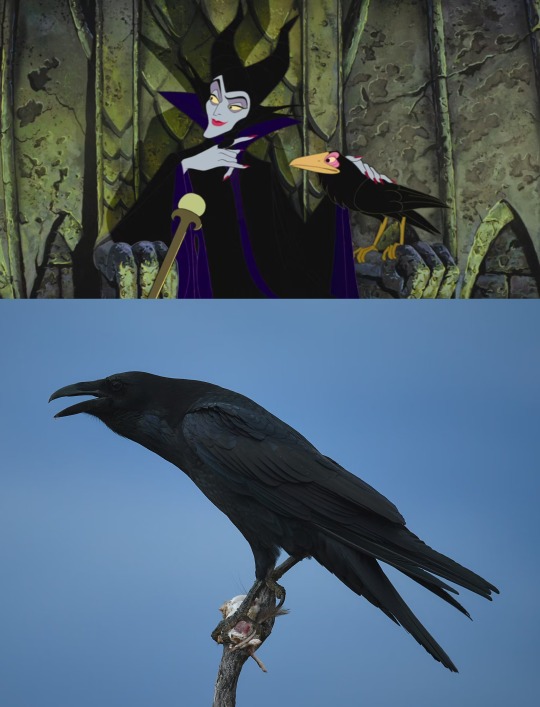
©Disney
©Henry
Captain Hook: Magnificent Frigatebird (Fregata magnificens)
Obviously

©Disney
©Andy Morffew
Lady Tremaine: Ruff (Calidris pugnax)
Her daughters would LOVE this outfit
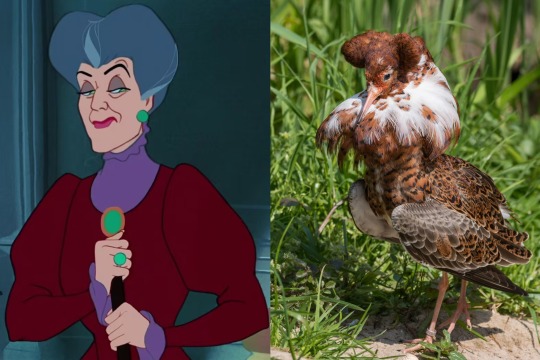
©Disney
©Mibby23
THANKS SO MUCH FOR READING!
BONUS: Kuzco

©Richard Gibbons
#disney villains#birds#prince hans#judge frollo#hades#queen of hearts#evil queen#jafar#yzma#cruella de vil#dr. facilier#mother gothel#gaston#ursula#maleficent#captain hook#lady tremaine#did tons of research on this#So tired omg going to bed#emperor kuzco#kuzco#Bro got turned into a bird this time
376 notes
·
View notes
Text

Andy Morffew
Caracara Courtship Display
This pair of crested caracaras throw
their heads back in their courtship
display.
54 notes
·
View notes
Text
How to Identify Belted Kingfishers
Originally posted at my website at https://rebeccalexa.com/how-to-identify-belted-kingfishers/. Click here to learn more about the How to Identify article series.
Name: Belted Kingfisher (Megaceryle alcyon)
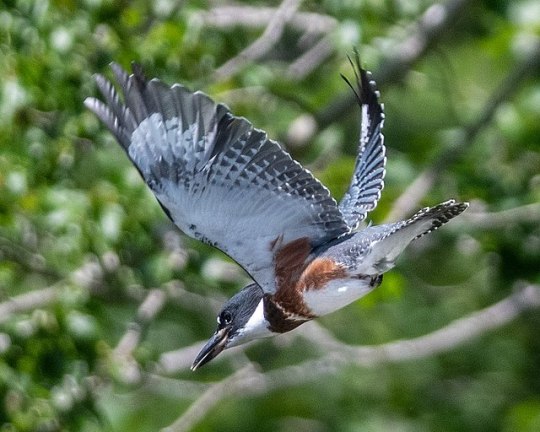
Adult female belted kingfisher. By Mister Pingo, CCA-SA-4.0
Range and typical habitat(s): Widespread across much of North America except for Arctic areas, all through Central America, and the northern coastline of South America; occasional vagrants in Greenland, Iceland, British Isles, and elsewhere. Commonly found along both fresh and salt water, often seen perching in trees or on other structures while they watch for potential food in the water.

Distinguishing physical characteristics (size, colors, overall shapes, detail shapes): Belted kingfishers are around a foot long; the head with its long, spear-shaped bill, is rather large in proportion to the rest of the body, especially when the crest of feathers on the back of the head is raised. The wingspan is generally about 18-23 inches across.
Adult belted kingfishers are a dusty grayish blue on the head, back and wings, and a blue band across the breast. The neck has a wide ring of white around it, and the belly and other underparts are white as well. Look for a small patch of white in front of each eye. Adult females additionally have a rust-colored band across the belly; this is the easiest way to tell the difference between the sexes. Immature birds of both sexes have similar blue and white markings, except both have a rust belly band with white flecks, and the breast stripe is rust instead of blue.

The primary wing feathers of both sexes are white with black tips underneath, and black with a wide white band on top; the secondaries have incomplete black stripes underneath, and are back and blue with white spots on top; and the tertiaries and coverts are blue on top and white underneath. The tail feathers are blue with white stripes. The bill and feet are dark gray.
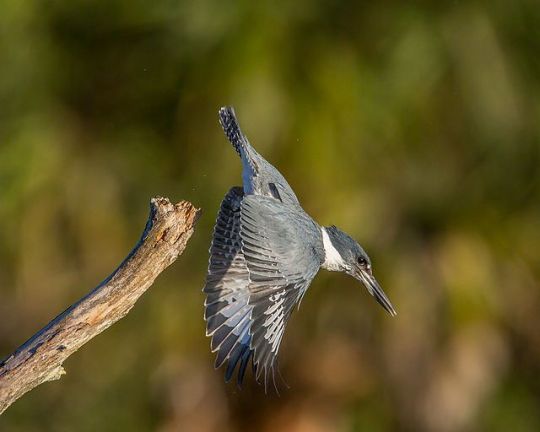
Belted kingfisher diving. By Andy Morffew, CCA-2.0
The belted kingfisher’s posture when perched is upright and alert. When diving into the water to catch prey, it holds its wings outspread, but then tucks them closer to its body just before it hits the water.
Behavior: Since these birds live primarily on fish, amphibians, and other aquatic prey, they’re most often observed waiting for food, or making a lighting-fast dive. However, they’ve also been known to eat mollusks, insects, small mammals, berries, and other terrestrial foods. In the nest, the young are able to digest the entire prey including bones and exoskeletons, but once older they regurgitate pellets of indigestible materials.
Belted kingfishers form monogamous pairs, and build their nests in cavities in dirt banks and cliffsides. These can be up to six feet deep, with an upward slope which helps to keep water out, to include during flooding. The female lays up to eight plain white eggs in each brood, and may have up to two broods a year. They hatch in a little over three weeks, and the young stay in the nest for almost a month before fledging.
If there’s a threat, belted kingfishers raise their crest of feathers and bounce their body up and down. They may also fly in an agitated manner while making loud rattling noises. Belted kingfishers often rattle while in flight, so keep your ears open near waterways.
Other organisms it could be confused with and how to tell the difference: The ringed kingfisher (Megaceryle torquata) looks quite similar to the belted kingfisher, but is larger and heftier, and both sexes have a copper-rust breast and belly.

Ringed kingfisher. Note the rust-copper breast and belly, as opposed to the single rust band across the banded kingfisher’s breast.
The green kingfisher is much smaller than the belted, and has a proportionately longer bill. It is metallic green where the belted is blue, and the male has a rust-copper breast while the female has a couple of green bands across the breast and no rust. Both of these lookalikes’ ranges barely reach North America, but overlap significantly with the belted range in Central and South America.

Male green kingfisher; note the green head, back and wing and the copper-rust breast with white belly. By Cláudio Dias Timm, CCA-SA-2.0
Anything else worth mentioning? Belted kingfishers are primarily found near natural waters, but may also be seen near artificial ponds with goldfish or other cultivated fish. And though they are most frequently sighted near water, they can be seen further inland from time to time.
Also, fun fact: it’s thought that both the belted kingfisher and its ringed cousin evolved from an African kingfisher species that found its way to the Americas millions of years ago.
Further reading:
All About Birds: Belted Kingfisher
Audubon Field Guide: Belted Kingfisher
American Bird Conservancy: Belted Kingfisher
Missouri Department of Conservation: Belted Kingfisher
Did you enjoy this post? Consider taking one of my online foraging and natural history classes, checking out my other articles, or picking up a paperback or ebook I’ve written! You can even buy me a coffee here!
#kingfisher#birds#birdblr#ornithology#wildlife#animals#wild animals#biology#zoology#birdwatching#birding#nature#outdoors#environment#conservation#ecology#bird
129 notes
·
View notes
Text
Round 2, Side A: Match 23


[Image ID: Two pictures of gulls. The left is a lava gull standing in sand. The right is a Franklin's gull walking along a pebbly bank. /End ID]
The lava gull (Leucophaeus fuliginosus) is the rarest gull in the world. They are found only on the Galápagos Islands, predominantly the Santa Cruz, Isabela, San Cristobal, and Genovesa islands, with an estimated population of 300-600 individuals. They typically measure 51-55 cm (20-22 in) in length. Unlike other hooded gulls, their sooty brown-to-black head does not vary by season. They have red eyelids and white eye crescents. Their body is dark grey with paler grey underparts, their bill and legs are black, and their wings are dark grey with a white leading edge. On Genovesa they exploit the kleptoparasitic behavior of the magnificent frigatebird, capitalizing on botched attempts by the frigatebirds to steal fish from other seabirds. Unlike most gulls which nest close together, they are solitary nesters. They are listed as vulnerable by the IUCN.
The Franklin's gull (Leucophaeus pipixcan) is a small gull found in central Canada and northern United States and migrates to winter in Argentina, Chile, Peru, and the Caribbean. They typically measure 32-36 cm (13-14 in) in length and 85-95 cm (33-37 in) in wingspan. They have a black hood, red bill and legs, white eye crescents, dark grey back, and white underparts which sometimes show a rosy pink cast. Their dark grey wings have black tips with white spots at the very tips of the primaries and a white band at the trailing edge. They feed on worms and insects, small fish, crabs, and small amounts of vegetation. When foraging in water, they sometimes swim in circles to create a vortex to bring prey closer to the surface.
lava gull image by Andy Morffew
Franklin's gull image by Terry Sohl
7 notes
·
View notes
Text
Cancun's Enchanted Wilderness: Exploring Wildlife Wonders

The Diverse Wildlife of Cancun
Cancun, Mexico, is a destination renowned for its breathtaking beaches, but few travelers realize that it is also a sanctuary for a rich and diverse tapestry of wildlife. The Yucatan Peninsula, where Cancun is nestled, offers a unique blend of lush forests, pristine coastlines, wetlands, and mangroves, providing an ideal habitat for an astonishing array of animal species. Join us on an awe-inspiring journey as we unveil the extraordinary wildlife of Cancun.
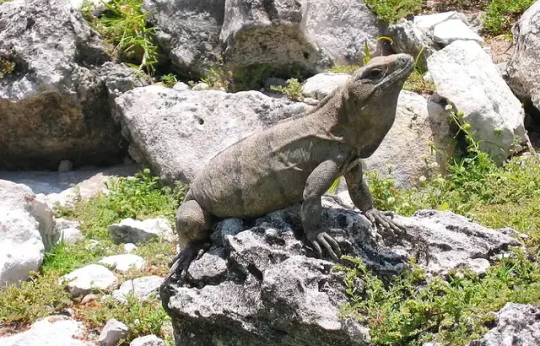
Iguana and rock, Cancun, Mexico. Photo by Paul Mannix. Flickr.
Common Wildlife Encounters
Coatis: The Forest Foragers
In the heart of Cancun's jungles, you might stumble upon coatis, small and agile mammals reminiscent of raccoons. With their long snouts and bushy tails, they thrive in the region's lush forests and lowland areas.
Iguanas: Guardians of Sunshine
Iguanas are a common sight in Cancun, sunbathing on rocks, tree branches, and even rooftops. They prefer coastal areas, parks, and golf courses, offering delightful encounters for visitors.
Flamingos: Graceful Lagoon Dwellers
Cancun's wetlands and lagoons are home to vibrant flocks of flamingos, known for their striking pink plumage. Watch these elegant birds wade in shallow waters, foraging for crustaceans and fish.
Butterflies: The Enchanting Flutter
The Yucatan Peninsula is a haven for butterflies, with diverse species gracing the region's lush flora. Be sure to visit butterfly sanctuaries and parks for an up-close encounter with their enchanting beauty.
Tarantulas and Snakes: Forest Elusiveness
In the forests and jungles surrounding Cancun, you may come across tarantulas and various snake species. While some are venomous, they typically avoid human contact and are often found in the undergrowth.

Roseate Spoonbill. Photo by Andy Morffew. Flickr.
Aquatic Marvels and Coastal Charm
Whale Sharks: Titans of the Deep
The crystal-clear waters off the coast of Cancun host one of the world's most breathtaking natural spectacles – the annual migration of whale sharks. These gentle giants, the world's largest fish, delight visitors with their filter-feeding habits.
Moths: Nocturnal Beauty
Cancun's tropical climate and lush vegetation create a perfect environment for a variety of moth species, adding a touch of nocturnal wonder to the region's biodiversity.
Pelicans and Seagulls: Coastal Sky Dancers
The coastal areas of Cancun are graced by pelicans and seagulls, especially around the fishing docks. Watch them glide gracefully over the turquoise waters, an ever-present sight.
Many Bird Species: A Birdwatcher's Paradise
Cancun offers a rich diversity of bird species, from the vibrant parrots and toucans to migratory birds passing through during different seasons. The region is a paradise for birdwatchers.
Marine Life: A World Below the Surface
Cancun's coral reefs teem with marine life, offering snorkeling and diving enthusiasts a chance to encounter a myriad of fish species, from colorful angelfish to enigmatic moray eels.
Crocodiles: Guardians of the Mangroves
The mangrove ecosystems and lagoons in Cancun are home to crocodiles, playing a crucial role in the region's ecosystem. These ancient reptiles embody the wild spirit of Cancun.

Green Sea Turtles in Akumal, Cancun, Mexico. Photo by Andresvilla. Wikimedia.
Elusive Enchantments and Coastal Conservation
Spider Monkeys: Jungle Acrobats
In the dense forests of Cancun, the acrobatic spider monkeys swing from tree to tree, adding to the region's mystical charm. Their habitats extend into the lush jungle areas.
Dolphins: Playful Ocean Spirits
Cancun offers visitors the extraordinary opportunity to swim with dolphins. Visitors can observe these intelligent and social creatures in their natural habitat, where they captivate with their playful antics.
Sea Turtles: Guardians of the Shore
Cancun plays a pivotal role in sea turtle conservation. Several sea turtle species, including the endangered loggerhead and hawksbill turtles, come ashore to nest on Cancun's pristine beaches.

Southern spotted skunk. Photo by Heidi Donat. Flickr.
Rare and Endangered Treasures
Jaguars: Elusive Jungle Royalty
Elusive and powerful, jaguars are one of the apex predators in Cancun's jungles, though sightings are rare. Conservation efforts are underway to protect their dwindling population.
Tapirs: Forest Giants
The dense tropical forests around Cancun are home to tapirs, large herbivores with distinctive trunk-like snouts. Unfortunately, they are categorized as vulnerable due to habitat loss.
Pumas and Ocelots: Stealthy Shadows
Pumas and ocelots, stealthy and agile cats, prowl the jungles and forests of Cancun, preying on small mammals and birds. Their numbers are decreasing due to habitat destruction.
Spotted Skunk: Nocturnal Puzzles
The spotted skunk, a small and nocturnal mammal with distinctive spots, is found in Cancun's jungles and forests. Urbanization poses a threat to their populations.
Sereque: Guardians of the Rainforest
Also known as the Central American agouti, the sereque is a large rodent inhabiting the region's forests and jungles. These creatures play a vital role in seed dispersal, an essential link in Cancun's intricate ecological web.
Cancun's natural beauty extends far beyond its pristine beaches, as it stands as a sanctuary for a stunning and diverse range of wildlife. Conservation efforts, protected areas, and eco-friendly practices are vital to preserving the region's unique ecosystems, ensuring that these captivating species continue to thrive in this tropical paradise. Come and discover the enchanted wilderness and wildlife in Cancun – a biodiversity odyssey that will leave you in awe.
Sources: THX News & Tripadvisor.
Read the full article
#AnimalSpeciesCancun#CancunAnimals#CancunBiodiversity#CancunEcosystem#CancunNature#CancunWildlife#Cancun'sEnchantedWilderness#DiverseWildlifeCancun#WildlifeConservationCancun#WildlifeinCancun
0 notes
Photo

A black-chinned mountain tanager (Anisognathus notabilis), a bird endemic to the high-altitude forests of Colombia and Ecuador.
Image by Andy Morffew via Wikimedia Commons (CC BY 2.0).
#andy morffew#photographer#wikimedia commons#black-chinned mountain tanager#anisognathus notabilis#bird photographer#colombia#ecuador#nature#tanager
48 notes
·
View notes
Note
May I request animals that were endangered but are now recovering please?
Was endangered, but has now recovered...
The first creature to come to mind is the American Alligator, which was in real trouble at one time, being close to extinction in the 1960s (due to overhunting and habitat destruction). Protection helped them recover by the 1980s.


American Alligator (Alligator mississippiensis), family Alligatoridae, Georgia, USA
photograph via: UGA Coastal Ecology Lab

Lake Erie Watersnake (Nerodia sipedon insularum), family Colubridae, found in islands of western Lake Eerie and in one county along the lake in OH, USA.
A subspecies of the Northern Water Snake.
Declared endangered in 1999, from habitat destruction, this snake had recovered by 2011, when it was removed from the endangered species list.
photograph by Jukka Palm

Bald Eagle (Haliaeetus leucocephalus), family Accipitridae, order Accipitriformes, Kachemak Bay, Alaska
Affected by variety of causes, overuse of DDT (a pesticide) hit them hard. The birds bioaccumulated the chemical through prey (mostly fish), causing the birds to produce thin egg shells, which would break easily when the parent sat on them.
Placed on the endangered species list in the 1970s, the birds had recovered by the 1990s, due to a ban on use of DDT in the U.S.
photograph by Andy Morffew
#alligator#reptile#herpetology#snake#water snake#bird#eagle#ornithology#animals#nature#north america
552 notes
·
View notes
Text
BOTD: Northern Bobwhite

Photo: Andy Morffew
"The only native quail in the east. Its whistled bob-white! call is a familiar sound in spring in farmland and brushy pastures. The birds are heard more often than seen; although not especially shy, they often keep within dense low cover. During fall and winter, bobwhites live in coveys, averaging about a dozen birds. At night they roost on the ground in circles, tails pointed inward, heads pointed out."
- Audubon Field Guide
#birds#northern bobwhite#birds of north america#north american birds#quail#quails#landfowl#bobwhites#birds of the us#birds of mexico#birds of the caribbean#birds of canada#birds of america#american birds#bird watching#birdblr#birblr#bird of the day#Colinus virginianus
24 notes
·
View notes
Video
A Stiff Drink? by Andy Morffew
Via Flickr:
Always amazes me to see giraffes drink. Taken at Zimanga.
0 notes
Photo

Kestrel by Andy Morffew Taken in Otterbourne, Hampshire. https://flic.kr/p/2mLxDCT
4 notes
·
View notes
Video
Talons Ready! by Andy Morffew
Via Flickr:
Taken in Alaska.
6 notes
·
View notes
Photo

Bald eagle
37 notes
·
View notes